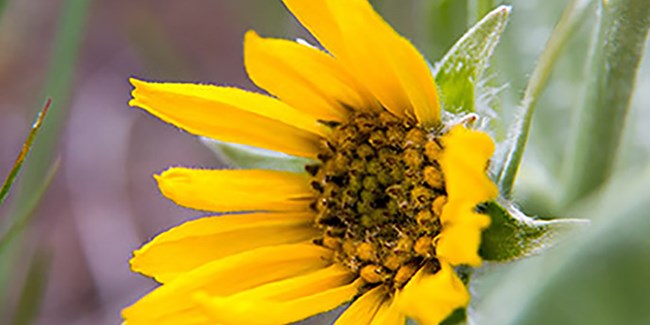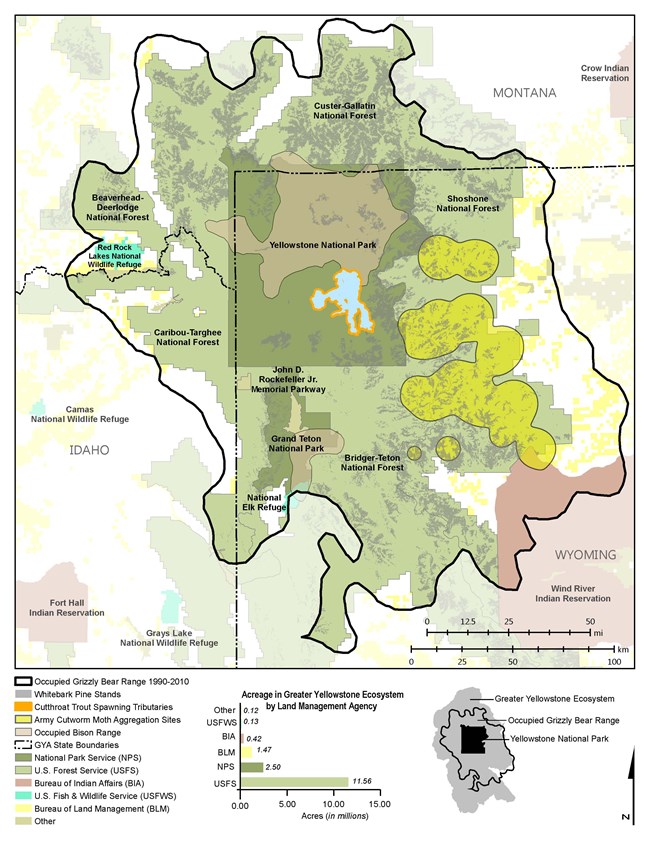
Kerry A. Gunther, Rebecca R. Shoemaker, Kevin L. Frey, Mark A. Haroldson, Steven L. Cain, Frank T. van Manen, & Jennifer K. Fortin
From Yellowstone Science 23(2): 2015, pages 7-11.
Dietary Breadth of the Grizzly Bear Our literature review indicated GYE grizzly bears eat an incredibly diverse array of foods, from those as large as bison and moose, to those as small as ants and midges. Grizzly bears of the GYE prey on fast and agile animals like elk, but also on slow and relatively immobile species such as earthworms. Some prey species fight back and are quite formidable to subdue, which we have observed when grizzly bears kill adult black bears or even other grizzly bears. Some insects, such as yellow jackets, put up a stinging defense but are not much of a threat to bears. Other species like ladybird beetles and cutthroat trout are relatively defenseless. In addition to prey species, grizzly bears eat many plants and mushrooms. Plants are consumed through grazing, digging, plucking, stripping, and peeling. Grasses, sedges, and clover are grazed; whereas, biscuitroot, yampa, and thistle roots are dug from the soil. Berries are plucked and stripped from branches and cambium is peeled from tree trunks. The foreclaws of grizzly bears are as long as 10 cm (4 inches) (Herrero 2002), and can be used to delicately dig up an individual yampa root or to 'rototill' acres of meadows to catch pocket gophers and dig up their food caches of plant roots. The average energy values of the ungulates (6.8 kcal/g), trout (6.1 kcal/g), and small mammals (4.5 kcal/g) eaten by grizzly bears were higher than those of the berries (3.2 kcal/g), forbs (2.9 kcal/g), and graminoids (2.5 kcal/g) they consumed (Craighead et al. 1995). At 7.9 kcal/g, army cutworm moths had the highest reported gross energy value of any food consumed (French et al. 1994). Some of the plant foods consumed, such as springbeauty, cow parsnip, and clover, are relatively high in protein. Other foods are rich in fats, like whitebark pine seeds and beargrass seed pods; whereas, others provide plenty of carbohydrates, such as oniongrass bulbs, yampa tubers, and roots of biscuitroot. In all, we documented more than 266 species in 200 genera from four different kingdoms (Plantae, Animalia, Fungi, and Protista) consumed by GYE grizzly bears (Gunther et al. 2014; see a list of the scientific names of all food items mentioned in this article at: nps.gov/yellowstonescience). Grizzly bears consumed more than 162 different plant species (149 native and 13 non-native), including at least 85 forbs, 31 shrubs and berries, 25 grasses, 4 sedges, 2 rushes, 4 aquatic plants, and 4 different species of ferns and fern allies as well as cambium, catkins, and nuts from 7 tree species. The primary forbs eaten were clover, dandelion, thistle, horsetail, yampa, and biscuitroot. Frequently consumed berries included whortleberry, huckleberry, and strawberry. The most frequently consumed graminoids were Kentucky bluegrass, sedges, and brome grasses. Seven species of mushrooms were consumed, including false truffles, puffballs, and morels. We also documented bears feeding on at least 26 mammal, 4 fish, 3 bird, and 1 amphibian species. Additional animal species are undoubtedly consumed opportunistically, but have not been documented. The primary mammals consumed were bison, moose, elk, mule deer, pocket gophers, voles, and ground squirrels; but mountain goats, marmots, mice, and pikas were also eaten. Grizzly bears consumed at least 36 species of invertebrates: primarily ants, army cutworm moths, yellow jackets, and earthworms. Twenty-four different species of ants were eaten including mound, ground, and log-dwelling species. It is easy to underestimate the importance of these insect species; however, ants are one of very few species that have been documented in every single grizzly bear scat-based diet study in the GYE from 1943 to 2009. Consumption of one algae (Knight et al. 1978) and one soil type (geothermal; Mattson et al. 1999) were also documented. Although the reason bears eat geothermal soil remains somewhat of a mystery, the soil may serve to restore mineral deficiencies because it contains high concentrations of potassium, magnesium, and sulfur (Mattson et al. 1999). Finally, grizzly bears consumed 26 species of domesticated plants and animals, including 13 species of cultivated agricultural, garden, and ornamental plants; 7 species of domestic livestock; and 4 species of domestic poultry, as well as domestic dogs and honey bees. Foraging Strategy Because of their need to accumulate large fat reserves for hibernation, grizzly bears are energy maximizers (Erlenbach et al. 2014). In grizzly bears, a diet of approximately 20% protein and 80% non-protein energy achieves maximum weight gain per unit of energy intake (Erlenbach et al. 2014, Coogin et al. 2014). To achieve this nutrient target and maximum weight gain, grizzly bears select mixed diets that maximize energy intake while optimizing macronutrient intake. This has been demonstrated in both wild and captive grizzly bears (Erlenbach et al. 2014, Coogin et al. 2014). The diverse diets of grizzly bears provides them the opportunity to eat appropriate proportions of nutritionally complementary foods during different seasons and in different geographic locations. Whenever available, grizzly bears seek foods of high caloric value that are concentrated on the landscape and can be efficiently foraged (Schwartz et al. 2003). Accordingly, frequently used foods included ungulates (bison, elk, moose, mule deer), cutthroat trout, army cutworm moths, and whitebark pine seeds. Bears make seasonal movements within their home ranges to areas where these foods are abundant, such as ungulate winter ranges, elk calving areas, spawning streams, moth aggregation sites on remote talus slopes, and forest stands containing whitebark pine. Most of these foods are subject to seasonal, annual, and geographic variation in availability, and therefore are not abundant or available during all seasons, every year, or within every individual bear's home range. If some of these concentrated high-caloric foods are not readily available, grizzly bears can usually shift their diet to other items, which may have lower caloric value but are widely distributed across the landscape and readily available most years. These lower-calorie foods include a wide variety of plants (clover, spring beauty, yampa, biscuitroot, bistort, other forbs, horsetail, grasses, and sedges), colonial insects (ants), fungi (false truffles and mushrooms), berries (huckleberry, whortleberry, and gooseberry), and small mammals (voles, ground squirrels, and pocket gophers). Spatial and temporal abundance and annual predictability of these foods can compensate for their lower caloric value;and, consequently, these foods can comprise a large proportion of grizzly bear annual diets (Craighead et al. 1982). Grizzly bears also supplement their diet with many foods consumed opportunistically. In fact, most foods we identified (including a variety of plants, fungi, vertebrates, and invertebrates) were consumed opportunistically with consumption varying annually based on availability and other factors. Opportunistic foods include a variety of species of plants, fungi, vertebrates, and invertebrates. Some opportunistic foods are consumed only during a short period each year (e.g., earthworms in wet meadows at the edge of the receding snowline during spring snow melt), while some are available only in small, localized areas (e.g., pondweed rhizomes from small ephemeral ponds within the Yellowstone caldera), and others are available only during sporadic periods of abundance (e.g., yellow jackets, grass hoppers, Mormon crickets, and midges). Many opportunistic foods are eaten primarily during periods with shortages of more preferred foods (e.g., yellow salsify and fernleaf licorice-root) or when randomly encountered while foraging for other species (e.g., mountain goats, grouse, boreal chorus frogs, and Utah suckers). Some foods of lower caloric value, such as grasses, sedges, and many forbs, may be consumed in areas between concentrations of higher-quality foods, thereby subsidizing travel and search costs (Mattson et al. 1984). Benefits of a Flexible Diet Grizzly bears in the GYE exhibit diet flexibility, consuming different foods depending on where their home ranges are located (figure 1). Some of the highest-quality foods are not found within all parts of the ecosystem and thus are likely not available to all GYE bears (figure 1). For example, army cutworm moths, bison, and cutthroat trout have limited distributions in the GYE, and even whitebark pine is only available to about two-thirds of all GYE grizzly bears (Costello et al. 2014). Because occupied grizzly bear habitat in the GYE is managed by many different state and federal agencies (figure 1), bears often cross jurisdictional boundaries to forage different food resources. Consequently, interagency cooperation is critical for successful, long-term conservation of grizzly bears and may be particularly important in the face of uncertainties such as climate change and expanding human occupation of the area. The diet flexibility demonstrated by Yellowstone grizzly bears greatly enhances their ability to occupy diverse habitats over a large geographic area. This diet flexibility likely also enhances their ability to cope with seasonal, annual, and longer-term perturbations in the abundance of high-calorie foods. Knowledge of the dietary breadth of grizzly bears helps managers of grizzly bears and their habitat document future changes in patterns of food consumption. This increased understanding provides managers with a strong foundation for making decisions about future grizzly bear management in the GYE. Changing climate and introduced non-native species will probably change the species composition and distribution of the plants and animals consumed by GYE grizzly bears. However, the adaptability and omnivore generalist lifestyle characteristics that allow grizzly bears to occupy diverse habitats throughout the world give us optimism that grizzly bears are capable of adjusting to these changes, provided that sufficient habitat is protected to allow grizzly bears to adjust to the changes, and human-caused mortalities are kept at sustainable levels. Literature Cited Coogan, S.C., D. Raubenheimer, G.B. Stenhouse, and S.E. Nielsen. 2014. Macronutrient optimization and seasonal diet mixing in a large carnivore, the grizzly bear: a geometric analysis. PLoS ONE 9:e97968. Costello, C.M., F.T. van Manen, M.A. Haroldson, M.R. Ebinger, S.L. Cain, K.A. Gunther, and D.D. Bjornlie. 2014. Influence of whitebark pine decline on fall habitat use and movements of grizzly bears in the Greater Yellowstone Ecosystem. Ecology and Evolution 4:2004-2018. Craighead, J.J., J.S. Sumner, and G.B. Scaggs. 1982. A definitive system for analysis of grizzly bear habitat and other wilderness resources. Wildlife-Wildlands Institute Monograph No. 1, U of M Foundation, University of Montana, Missoula, Montana, USA. Craighead, J.J., J.S. Sumner, and J.A. Mitchell. 1995. The grizzly bears of Yellowstone, their ecology in the Yellowstone Ecosystem, 1959-1992. Island Press, Covelo, California, USA. Erlenbach, J.A., K.D. Rode, D. Raubenheimer, and C.T. Robbins. 2014. Macronutrient optimization and energy maximization determine diets of brown bears. Journal of Mammology 95:160-168. French, S.P., M.G. French, and R.R. Knight. 1994. Grizzly bear use of army cutworm moths in the Yellowstone Ecosystem. International Conference on Bear Research and Management 9:389-399. Gunther, K.A., R.R. Shoemaker, K.L. Frey, M.A. Haroldson, S.L. Cain, F.T. van Manen, and J.K. Fortin. 2014. Dietary breadth of grizzly bears in the Greater Yellowstone Ecosystem. Ursus 25:60-72. Herrero, S. 2002. Bear attacks: their causes and avoidance. Revised edition. The Lyons Press, Guilford, Connecticut, USA. Knight, R., J. Basile, K. Greer, S. Judd, L. Oldenburg, and L. Roop. 1978. Yellowstone grizzly bear investigations: annual report of the Interagency Study Team, 1977. U.S. Department of the Interior, National Park Service, Bozeman, Montana, USA. Mattson, D.J., B.M. Blanchard, and R.R. Knight. 1984. Food habits of the Yellowstone grizzly bear. Interagency Grizzly Bear Study Team, Bozeman, Montana, USA. Mattson, D.J., G.I. Green, and R. Swalley. 1999. Geophagy by Yellowstone grizzly bears. Ursus 11:109–116. Schwartz, C.C., S.D. Miller, and M.A. Haroldson. 2003. Grizzly bear. Pages 556–586 in G.A. Feldhamer, B.C. Thompson, and J.A. Chapman, editors. Wild Mammals of North America: Biology, Management, and Conservation. Second edition. The John Hopkins University Press, Baltimore, Maryland, USA. 
|
Last updated: December 21, 2015
